
Brainstorm Security Shop

For Orders Over $199

On Any Of Our Products

Details On Refund Page
You’ve likely heard about the typical benefits of a home security system, but have you considered the advantages of integrating flood detection? Imagine you’re away on vacation or simply asleep, and a water leak starts. Without flood sensors, you might return to extensive damage, leading to significant repair costs. However, with flood detection for home security systems, you’re alerted immediately when unexpected water levels are detected, allowing you to act swiftly to mitigate potential disasters. Now, consider this: what if there’s more to these systems than just preventing water damage? What other benefits could they offer that aren’t as widely discussed?
Why should you consider integrating flood detection into your home security system? The reasons are more compelling than you might initially think. Floods are the most common natural disaster, and they can occur almost anywhere—not just near rivers, lakes, or coastal areas.
It’s not just about major disasters; even a small amount of water leakage can cause significant damage to your home. By including flood detection, you’re essentially safeguarding your investment in your property. Water damage can be extremely costly, not just in terms of repairs but also in the loss of personal items that might be irreplaceable.
Imagine the peace of mind you’d have knowing that you’ll be alerted before these damages escalate. It’s an additional layer of security that monitors your home environment, protecting it from potential water-related disasters.
Moreover, this proactive approach can significantly reduce insurance claims related to water damage, potentially lowering your premiums. It also helps maintain the value of your home, as frequent water issues can lead to long-term structural problems.
To effectively monitor your home for water intrusion, consider the various types of flood sensors available. Each type has its own unique features and suitability depending on your needs and the layout of your home.
First, there’s the surface sensor, which you’ll find most straightforward to use. It’s designed to detect water as soon as it hits the ground – perfect for basements or laundry rooms. You’ll know right away if there’s an issue, as these devices typically trigger an alarm or send you a notification.
Then, you’ve got the probe sensors. These are a bit more versatile. You can install them in tight spots, like under your dishwasher or by your water heater. They work by detecting moisture at any contact point along the probe, making them ideal for catching leaks that might occur in hard-to-see locations.
Don’t forget about ultrasonic sensors, which use sound waves to measure water levels. These are particularly useful in sump pumps or wells. They can help you keep an eye on rising water levels without having to physically check these areas.
Choosing the right flood sensor can give you peace of mind, knowing that you’re prepared to tackle potential water damage head-on.
Installing your chosen flood sensors involves a few key steps to ensure they function effectively in your home.
First, you’ll need to decide on the optimal locations for these sensors. Think about areas that are prone to water accumulation, such as basements, near water heaters, under sinks, or by washing machines. It’s important that these sensors are placed on the floor or close to it, as water naturally pools downwards.
Once you’ve pinpointed the spots, it’s time to mount the sensors. Most flood sensors are designed for easy installation, typically involving peel-and-stick adhesives or simple screw mounts. Make sure the surface is clean and dry before you attach the sensor to ensure it sticks properly.
Next, you’ll need to connect the sensors to your main home security system. This is usually done wirelessly, which means you won’t have to deal with complicated wiring. Simply follow the manufacturer’s instructions to sync each sensor with your system.
It’s crucial to test the sensors after installation to confirm they’re functioning as expected. Pour a small amount of water on the floor where the sensor is located to see if it triggers an alert to your system. This step confirms everything is set up correctly.
Once your flood sensors are installed, monitoring and receiving alerts becomes straightforward and automated. You’ll be able to keep tabs on potential water intrusion without constant manual checks, which means less worry for you and more protection for your home.
Your system’s central unit continuously scans data from the flood sensors. If they detect water, you’ll receive an immediate notification. Depending on your preferences, these alerts can pop up as text messages, emails, or app notifications on your smartphone. You can even set them to alert a neighbor or your local security service if you’re away from home.
It’s also crucial to regularly test your flood sensors to ensure they’re functioning correctly. Most systems let you do this via your main control panel or a connected app. Routine tests help prevent false alarms and ensure that you won’t be caught off guard when you need protection the most.
Integrating your flood detection system with other home security components enhances overall safety and efficiency. By connecting flood sensors to your main security system, you’re creating a unified network that can respond more rapidly in emergencies. If your flood sensors detect water, they can automatically trigger your home’s alarm system, send notifications to your smartphone, and even shut off the main water supply to minimize damage.
Linking your flood detection to smart home devices expands functionality. For instance, integrating with smart lighting allows lights to flash in case of flood detection, serving as an additional alert mechanism. Cameras can also be programmed to start recording when flood sensors activate, providing real-time footage of the affected areas. This integration can be crucial for assessing the situation remotely and deciding the next steps more effectively.
Moreover, connecting your flood detection system with home automation platforms like Google Home or Amazon Alexa enables voice-activated controls. You can check the status of your sensors or command actions through simple voice commands, adding an extra layer of convenience and accessibility.
This interconnected approach not only boosts the responsiveness of your home security system but also simplifies managing various components from a single interface, ensuring you’re better prepared for any water-related emergencies.

Considering the benefits, you’ll find that the cost of adding a flood detection system to your home security setup can be quite reasonable. The price range varies widely based on the complexity and coverage of the system you choose. Basic detectors can start as low as $50, making them an accessible option if you’re on a tight budget.
For more comprehensive protection, systems can integrate with your current home security for a seamless experience. These advanced systems might set you back a few hundred dollars, but considering the potential damage costs from flooding, it’s a worthwhile investment.
You might also find that many home insurance providers offer discounts for homes equipped with flood detection systems, which can help offset the initial expense.
When planning your budget, remember to account for the installation costs. While some systems are DIY-friendly, professional installation ensures that sensors are placed optimally for accurate flood detection. The cost of professional services can vary, but typically, it’s a small price to pay for the added assurance and potential prevention of costly flood damage.
To keep your flood detection system functioning optimally, regularly check and clean the sensors. Dirt, dust, and other debris can accumulate on the sensors, potentially hindering their ability to detect water accurately. It’s best to use a soft, dry cloth for cleaning. Avoid using any harsh chemicals that might damage the sensor surfaces.
You should also test the system monthly. Run a simulation of a flood scenario by applying a small amount of water directly to the sensors. This checks if the alarms and notifications are functioning as expected. Ensure you dry the sensors thoroughly after testing to prevent residual moisture from causing false alarms.
Don’t forget to check the batteries if your system is wireless. Weak or dead batteries can lead to system failure during critical times. Replace them annually, or as recommended by the manufacturer, to ensure continuous protection.
Lastly, keep an eye on the system’s software and update it regularly. Manufacturers often release updates to improve functionality and security. These updates can also fix bugs that might affect the performance of your flood detection system. Staying updated helps you maintain an effective line of defense against potential water damage.
Let’s explore some real-life stories from homeowners who’ve experienced the benefits of installing a flood detection system.
Sarah from Florida shares that during a particularly heavy storm, her flood detection system alerted her before the water breached her garage. This early warning allowed her to safeguard her valuables and minimize damage, saving her thousands in potential losses. ‘It was a game changer,’ she says.
Tom in Louisiana tells a similar story. His flood detection system warned him of rising water levels while he was away on vacation. He was able to call a neighbor to check on his house, who confirmed the alert and helped move critical items to higher ground. ‘Without the system, I’d have come back to a disaster,’ he admits.
Lastly, Emily from Texas praises the peace of mind her system provides. ‘Last year, the flood alerts gave us enough time to evacuate safely before the situation worsened,’ she recalls. Her family avoided the trauma of being caught in floodwaters, and their preparedness ensured their home suffered minimal damage.
These testimonials underscore not just the practicality but the essential role that flood detection systems can play in protecting homes and families.
You’ve seen how vital a home security system with flood detection can be. From choosing the right sensors to understanding the installation process and integrating with other systems, you’re equipped to make informed decisions.
Don’t forget to consider the costs and maintenance to keep your system running smoothly. Remember, investing in such a system not only protects your home from water damage but also gives you peace of mind.
Ready to safeguard your home? It’s time to take action.

Brainstorm Security Shop
1867 Caravan Trail
Ste 105
Jacksonville, FL 32216
Call us toll free: (800) 859-5566